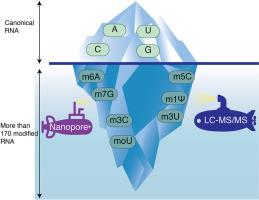直接RNA修饰制图:技术进步、差距和新趋势
IF 12
1区 化学
Q1 CHEMISTRY, ANALYTICAL
引用次数: 0
摘要
定位RNA修饰对于阐明生物学途径和确保治疗性RNA的质量和安全性至关重要。这篇综述批判性地考察了当前和新兴的通过直接RNA测序来绘制RNA修饰的技术。自上而下的质谱法(MS)适用于短rna,而自下而上的质谱法适用于较长的rna。多维液相色谱(MD-LC-MS)和在线消化技术的最新发展提高了样品吞吐量,同时减少了样品需求。然而,只有少数核酸酶的商业化和合适软件包的缺乏长期阻碍了完整的序列覆盖和非靶向分析。纳米孔测序在非靶向、长读分析RNA修饰方面表现出色。纳米孔测序的准确性是有限的,并且修改感知基调用器需要大量的数据集进行训练和强大的计算工具进行分析。需要进一步的研究来充分利用这些技术在绘制RNA修饰和可能阐明RNA结构方面的潜力。本文章由计算机程序翻译,如有差异,请以英文原文为准。

Direct RNA modification mapping: Technological advances, gaps, and emerging trends
Mapping RNA modifications is essential for elucidating biological pathways and ensuring the quality and safety of therapeutic RNAs. This review critically examines current and emerging technologies for mapping RNA modifications by direct RNA sequencing. Top-down mass spectrometry (MS) is preferred for short RNAs, whereas bottom-up MS suits longer ones. Recent developments in multidimensional liquid chromatography (MD-LC-MS) and online digestion techniques have improved sample throughput while reducing sample requirements. However, the commercialization of only a few nucleases and the scarcity of suitable software packages have long impeded full sequence coverage and untargeted analysis. Nanopore sequencing excels in untargeted, long-read analysis of RNA modifications. The accuracy of nanopore sequencing is limited, and modification-aware basecallers require large data sets for training and powerful computational tools for analysis. Further research is needed to harness the full potential of the technologies in mapping RNA modifications and possibly elucidating RNA structures.
求助全文
通过发布文献求助,成功后即可免费获取论文全文。
去求助
来源期刊

Trends in Analytical Chemistry
化学-分析化学
CiteScore
20.00
自引率
4.60%
发文量
257
审稿时长
3.4 months
期刊介绍:
TrAC publishes succinct and critical overviews of recent advancements in analytical chemistry, designed to assist analytical chemists and other users of analytical techniques. These reviews offer excellent, up-to-date, and timely coverage of various topics within analytical chemistry. Encompassing areas such as analytical instrumentation, biomedical analysis, biomolecular analysis, biosensors, chemical analysis, chemometrics, clinical chemistry, drug discovery, environmental analysis and monitoring, food analysis, forensic science, laboratory automation, materials science, metabolomics, pesticide-residue analysis, pharmaceutical analysis, proteomics, surface science, and water analysis and monitoring, these critical reviews provide comprehensive insights for practitioners in the field.
 求助内容:
求助内容: 应助结果提醒方式:
应助结果提醒方式:


